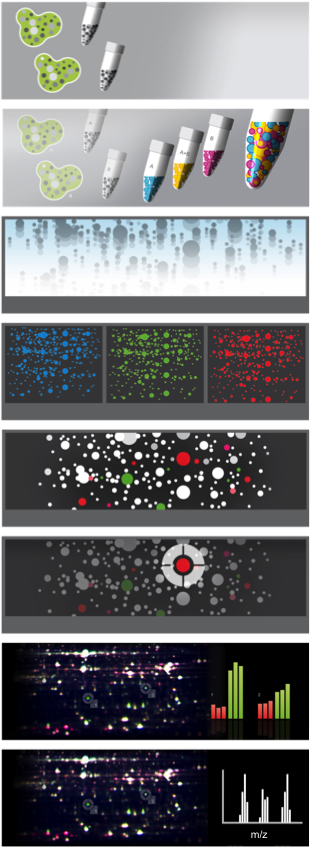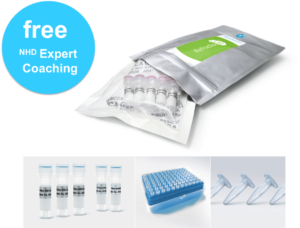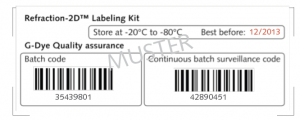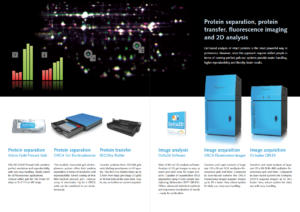Refraction-2D™ Labeling Kits
Refraction-2D™ ist die führende Technologie für die Multiplex-Fluoreszenz 2D-Gelelektrophorese (auch als Differential Gel Electrophoresis, 2D DIGE bekannt).
Labeling mit Refraction-2D™ erfolgt über die kovalente Bindung von stark fluoreszierenden G-Dyes (blau: G-Dye100, grün: G-Dye200, rot: G-Dye300 und infrarot: G-Dye400) an Lysin, der abundantesten Aminosäure in Proteinen. Durch besondere chromophore Gruppen der G-Dyes wird eine höhere Quanteneffizienz im Vergleich zu Cyaninen erreicht. Damit können auch niedrig abundante differentiell regulierte/modifizierte Proteine direkt und sicher in einem 2D Gel detektiert werden.
Refraction-2D™ bietet Ihnen ...
- • bis zu 4 Proben in einem 2D Gel laufen zu lassen
- • Proteine bis zu 0.03 ng zu detektieren
- • zuverlässig auch geringe Proteinregulationen zu manifestieren
- • Post-translationale Modifikationen sicher zu identifizieren
- • direkt Spots aus den Gelen zu picken - ohne Anfärben
- • Experten-Support durch unsere 2D Coaches
.
Die Labeling Kits sind ready-to-use und erhältlich als
- • 3-Farben Kit Refraction-2D™ für RGB-Multiplexing
(G-Dye100, G-Dye200, G-Dye300). - • 4-Farben Kit Refraction-2D™ QPLEX für RGB-IR-Multiplexing
(G-Dye100, G-Dye200, G-Dye300, G-Dye400).
Für die Aufnahmen von 2D-Gelen (und 2D-Western Blots) mit einer Größe bis 30x 25 cm haben wir ein robustes Hochleistungssystem entwickelt.
Der Octoplus QPLEX (RGB-IR + ECL) kann in seiner Leistungsfähigkeit mit modernsten Fluoreszenz-Scannern konkurrieren. Zudem ist der Octoplus QPLEX bis zu 10x schneller, ist hochempfindlich für Chemilumineszenz-Detektion (z.B. 2D-Western Blots) und nicht kaputt zu kriegen.
Für die Auswertung von Refraction-2D™ Gelen haben wir für Sie die modernste 2D Software nämlich Delta2D im Portfolio.
Refraction-2D™: 100% Made in Germany

.
Refraction-2D™ Labeling Kits
| Prod. Nr. | Bezeichnung | Kitgröße | Preis |
| PR08 | Refraction-2D
Labeling Kit |
4G
(1x 1.8 nmol) |
Angebot |
| PR08G | Refraction-2D
Labeling Kit |
2x 4G
(2x 1.8 nmol) |
Angebot |
| PR09 | Refraction-2D
Labeling Kit |
12 G
(1 x 5 nmol) |
Angebot |
| PR60 | Refraction-2D
QPLEX Labeling Kit |
4G
(1x 1.8 nmol) |
Angebot |
| PR61 | Refraction-2D
QPLEX Labeling Kit |
2x 4G
(2x 1.8 nmol)
|
Angebot |
| PR62 | Refraction-2D
QPLEX Labeling Kit |
12G
(1x 5 nmol)
|
Angebot |
.
.

.
Refraction-2D™ Kit-Inhalt
- • G-Dye100 - Hochleistungsfarbstoff
- • G-Dye200 - Hochleistungsfarbstoff
- • G-Dye300 - Hochleistungsfarbstoff
- • G-Dye400 - Hochleistungsfarbstoff (nur bei QPLEX Kits)
- • G-Dye Lösungsmittel
- • G-Dye Stop-Lösung
- • G-Dye Low Retention Pipetten-Spitzen
- • G-Dye Low Retention Reaktionsgefäße
- • G-Dye100 Spot Picking Kit (kostenlos ab Kitgröße 12G)
- • Expert Support durch unsere 2D Coaches
.
.

.
Refraction-2D™: Geprüfte Qualität
Um Ihnen eine gleichbleibende Qualität Ihrer Analysen zu sichern, unterliegen alle G-Dyes und die dazugehörigen Refraction-2D™ Protein Labeling Kits strengsten Qualitätskontrollen. Jedes Batch wird auf Sensitivität und Labeling-Effizienz hin überprüft und nur erfolgreich getestete Kits verlassen unser Haus. Alle Batches werden bis zum Ablauf des von uns empfohlenen Verwendungsdatums 2-wöchentlich überwacht.
.
.

.
Refraction-2D™ Publikationen
Zadražnik T, Hollung K, Egge-Jacobsen W, Meglič V, Šuštar-Vozlič J: Differential proteomic analysis of drought stress response in leaves of common bean (Phaseolus vulgaris L.). Journal of Proteomics 2013; 78: 254-272.
Fonseca C, Planchon S, Serra T, Chandler S, Saibo N, Renaut J, Oliveira MM, Batista R (2012): Selection of the best comparator for the risk assessment of GM plants - conventional counterparts vs. negative segregant. Poster presentation
Gemoll T, Laubert T, Grimme C, Roblick UJ, Habermann JK. Hochauflösende 2D-Gelelektrophorese von Knochengewebsproben. Biospektrum 2012; 18 (5): 520-521.
Weitere Publikationen und Referenzen finden Sie hier.
.
Weitere Informationen
.
Manuals
PDF Refraction-2D™ Produkt Guide.(deutsch)
.
PDF Refraction-2D™ QPLEX Produkt Guide (deutsch)
.
PDF Refraction-2D™ Spot Picking Guide (deutsch)
.
.
Sicherheitsdatenblatt
PDF Refraction-2D™ Sicherheitsdatenblatt
Broschüren
PDF Refraction-2D™ QPLEX (Kurz-Broschüre)
.
PDF Product line 2DE (Broschüre u.a. mit Übersicht über unser Labeling-Kit Portfolio)
.
PDF Imaging von 2D Gelen (Tipps und Tricks von DECODON)



